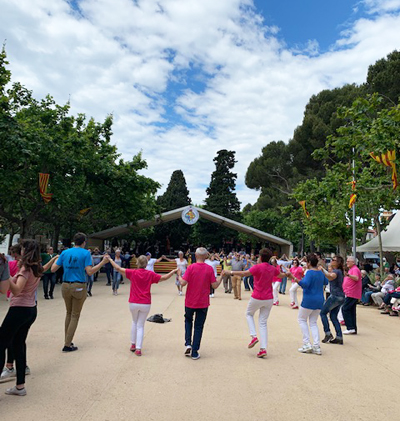Dance: The Catalan Sardana Revisited
By Dawn Lille
arttimesjournal June 19, 2019
 Sardana Dance |
There is a story that has circulated for many years in Spain: the devil came to Catalunya planning to engage in a business venture. He paused to watch a group performing the sardana, the national dance of this region of Spain. After a while he left, saying if they were so serious when they were supposed to be enjoying themselves, they would be unapproachable in business.
It is 13 years since I first wrote about this special folk dance from an area of Spain that was a country before 1492 and whose language, Catalan, was prohibited during the 36 year dictatorship of Franco, who did all he could to smother the Catalan pride in its heritage.
In recent years Catalunya, the largest and most economically profitable area of Spain, with Barcelona its leading city, has had more than one vote to become independent, although this desire was first expressed more than 150 years ago. After the last vote, declared illegal (rightfully according to the law) by the central government in Madrid, several of the independence leaders were jailed and remain so, which has not diminished the battle for separation.
It was thus more than interesting to witness a festival taking place in Sant Feliu de Guixols, the essence of which celebrated the continuity of and pride in a preserved heritage. Sant Feliu is a town of 21,000 on the Mediterranean about 70 kilometers north of Barcelona. It is in an area of magnificent rocky coves and beaches, known as the Costa Brava, that is midway between Barcelona and the French border.
Its origins go back to the 11th century with the establishment of a monastery. Once home to large cork and fishing industries and the target of seaside shelling by Franco forces during the civil war, it is now a popular tourist destination. There is still a Sunday market, Twelfth night is still celebrated with three kings on horseback and most people in town know each other. Years ago sardana gatherings took place in the local bullring, that has since been demolished.
 Cobla Band |
Sant Feliu has its own group of dancers and musicians, plus others who join in at their several outdoor gatherings. They have been designated "The 2020 Capital of the Sardana," a title that is bestowed upon a different city every year. The participants in this event came from all over Catalunya, groups of recreational dancers who enjoy moving together. The large group from Lerida, the capital of the province, wore bright pink t- shirts and the women had matching pink espadrilles.
There is an organized effort to teach the dance to children and young musicians to play in the Cobra band. The dance is often mentioned in literature and many artists have portrayed it.
The origins of the sardana are not clear. Some trace it back to the Phoenicians. It was part of the 17th century Spanish courts and for many years it was danced by the alter boys after Sunday church services. It is still danced in front of the cathedral in Barcelona and in various plazas of the city on festival days, as well as towns and cities throughout the region. .
Performed in a circle, with the participants holding hands and raising their arms, it is ideally danced on the ball of the foot, with the heel never touching. Alternating feet, they perform a pattern of small, light, precise taps and crossover movements dictated by the music. The body never stops keeping the inner rhythm, which builds to a flowing bounce. With some the levitation is high off the ground. The steps are grouped into short and long patterns. The almost hidden subtleties make the dance more complicated than it first appears. Particularly challenging are the sudden shifts of weight.
There can be as few as two people in the circle, which is open to all ages and backgrounds. One can join at any time as long as they are able to follow the exact pattern of steps. Once open to men only, this can be a group of any sort, although if it is a traditional couple dance females and males alternate and breaking in as a single is frowned upon, as is the entrance of an inexperienced dancer. Sometimes it is a circle within a circle; often newcomers form another circle.
This dance is not done without the music performed by the Cobla band, which is made up of 11 basically woodwind musicians. There is brass, a bass, a small drum, a small flute called a flavio, instruments in the oboe family and a tambourine. They are a serious group, usually men.
Musically the sardana form is continually enriched with new compositions, each with its own pattern of repeats of short and long melodic and rhythmic sections, to which the dancers relate directly. Hence they must listen carefully. The circle always has a leader who pays attention to the long and short steps, the sections of the music and the repeats. The goal is to end in the same spot as you began.
In this era of political division in Spain, as well as in much of the world, it is thought provoking to witness a dance performed by ordinary people that has become a symbol of unity. One can also add that it is a reminder of a certain point of view, that was banned by Franco. In any case, it represents the power of an art form.
dawnlille@aol.com
